Much of the Middle East is aflame, with the fires of war burning far beyond the borders of Israel and the Palestinian territories.
Ever since the Hamas attacks on Israel nearly four months ago, fears have grown that the region’s many conflicts – some of which began long before the Oct. 7 Hamas rampage through southern Israel – might grow together into a single inferno.
That hasn’t happened yet, but in the wake of a series of deadly tit-for-tat attacks around the region, the chances of a direct clash between the United States and Iran – the main backers of Israel and Hamas – are the highest they have been in years.
Fears have peaked since a Jan. 28 drone strike by an Iranian-backed militia that killed three U.S. soldiers stationed in Jordan. On Friday, the U.S. response began with a wave of air strikes targeting a reported 85 Iranian-linked targets in Iraq and Syria, though none inside Iran itself. The operation is expected to last several days, though President Joe Biden has said he doesn’t want to see a wider war.
Here’s a look at the situation across the Middle East, almost four months into the latest crisis.
The belligerents and their backers

LEBANON
SYRIA
GOLAN
HEIGHTS
Jerusalem
GAZA
STRIP
WEST
BANK
ISRAEL
EGYPT
JORDAN
U.S. allies
RUSSIA
TURKEY
SYRIA
IRAQ
IRAN
JORDAN
KUWAIT
BAHRAIN
EGYPT
UAE
SAUDI
ARABIA
OMAN
SUDAN
YEMEN

LEBANON
SYRIA
GOLAN
HEIGHTS
Jerusalem
GAZA
STRIP
WEST
BANK
ISRAEL
EGYPT
JORDAN
U.S. allies
RUSSIA
TURKEY
SYRIA
IRAQ
IRAN
JORDAN
KUWAIT
BAHRAIN
EGYPT
UAE
SAUDI
ARABIA
OMAN
SUDAN
YEMEN

KAZAKHSTAN
U.S. allies
RUSSIA
UZBEKISTAN
GEORGIA
TURKMENISTAN
TURKEY
SYRIA
AFGHANISTAN
LEBANON
ISRAEL
IRAQ
IRAN
PALESTINIAN TERRITORIES
JORDAN
KUWAIT
BAHRAIN
EGYPT
QATAR
UAE
SAUDI
ARABIA
OMAN
SUDAN
YEMEN
ERITREA
ETHIOPIA
Israel
Israel responded to the Oct. 7 attacks – which killed more than 1,200 Israelis and saw more than 200 others taken hostage by Hamas – with a furious assault on the Gaza Strip, vowing to destroy the militant group and bring home the hostages.
Some 120 days later, more than 27,000 Palestinians have reportedly been killed, and satellite images suggest that more than half of the buildings in the narrow coastal territory have been badly damaged or destroyed.
There’s no question Hamas and Gaza have felt Israel’s wrath in response to the worst massacre of Jews since the Holocaust, but the top leaders of Hamas remain unaccounted for – presumed to still be alive in the tunnels beneath Gaza. Even Israeli officials wonder whether the Islamist group is being dismantled or if the offensive is instead creating another generation of anti-Israel militants. Most damning of all, 130 of the Israeli hostages remain missing, fuelling non-stop protests calling for Prime Minister Benjamin Netanyahu to agree to a ceasefire in exchange for a hostage release.
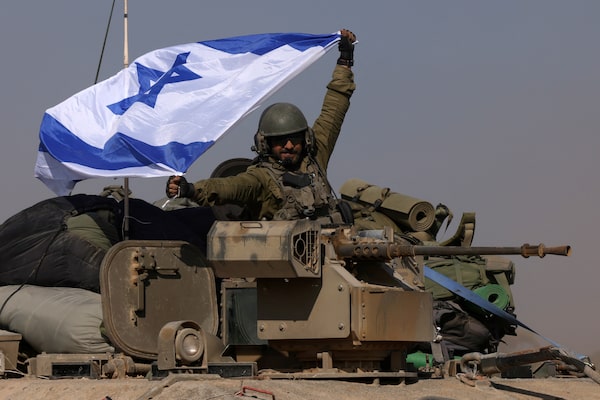
Near the Gaza border, an Israeli soldier waves the flag as troops roll back from the Palestinian enclave on Dec. 31.MENAHEM KAHANA/AFP via Getty Images
The most recent ceasefire proposal – brokered by the U.S., Qatar and Egypt – would see Israel pause its attack for 40 days in exchange for the release of all civilians among the remaining hostages. Hamas has signalled it will agree to the truce only if Israel fully withdraws from Gaza, something Mr. Netanyahu has vowed won’t happen until Israel’s war aims are achieved.
Deeply unpopular even before the conflict, Mr. Netanyahu – who has held office for all but 18 months since 2009 – knows his time in the Prime Minister’s Office is likely to end soon after the shooting does.
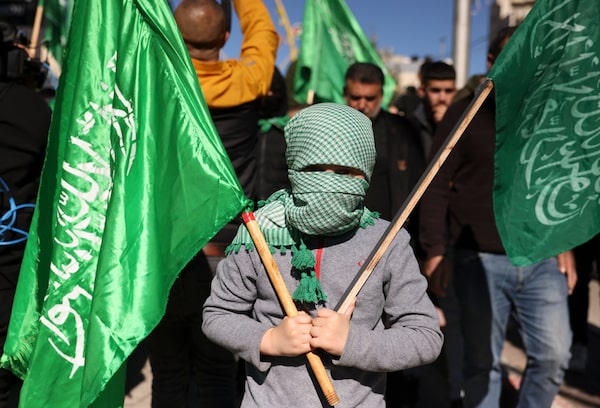
Protesters carry the green flag of Hamas after Dec. 15's Friday prayers in Hebron, in the occupied West Bank.HAZEM BADER/AFP via Getty Images
Hamas
The Islamist militant group traded a day of bloody retribution against Israel – a state it says has no right to exist – for the utter destruction of the territory it ruled. Israel says it has killed some 9,000 Hamas fighters, a figure that can’t be independently verified, and has lost 223 of its own soldiers. It seems clear that Israel will never again accept Hamas control over Gaza.
Despite all the death and destruction, Hamas appears to be more popular among Palestinians than it was before Oct. 7. Reflecting the anger and despair built up over 56 years of Israeli military occupation, a December poll by the Palestinian Centre for Policy and Survey Research found that 57 per cent of Gaza residents – and 82 per cent of Palestinians living in the West Bank – say Hamas was “correct” in launching its attack.
It’s an awkward truth that the Oct. 7 assault and the Israeli response to it have pushed the Palestinian issue – and a people’s long-thwarted quest for an independent state – back to the top of the international agenda for the first time in two decades.
Mahmoud Abbas, leader of the Palestinian Authority, meets in Ramallah with the prime ministers of Spain and Belgium on Nov. 23.ALAA BADARNEH/Pool via REUTERS
Palestinian Authority
For the past four months, the Palestinian Authority has seemed irrelevant. President Mahmoud Abbas hasn’t spoken to Mr. Netanyahu since the fighting began, and the PA’s lightly armed police forces have largely stood aside as deadly violence has flared repeatedly in the West Bank as well.
That said, the PA is likely to play a crucial role in whatever follows the war in Gaza. While Mr. Abbas’s Fatah movement – which Hamas ousted from Gaza at gunpoint in 2007 – won’t want to be seen returning to Gaza at the behest of Israel, any attempt to make a long-term peace between Israel and its neighbours will necessarily include the PA. Hopes for a breakthrough in that process rose this week when the Biden Administration signalled that it was considering recognizing a Palestinian state at the start, rather than the end, of any new negotiations.
A major obstacle to progress could be Mr. Abbas himself; the same December poll found that 88 per cent of Palestinians across the West Bank and Gaza thought their octogenarian leader should resign. His most popular replacement has long been Marwan Barghouti, a Fatah figure who has been in Israeli prison since 2002, serving five life sentences for his role in directing attacks on Israeli citizens at the height of the last intifada.
U.S. President Joe Biden and Israeli Prime Minister Benjamin Netanyahu meet in Israel on Oct. 18.Evelyn Hockstein/Reuters
United States
The U.S. sent two aircraft carrier groups to the region after Oct. 7 in what was a clear warning to Iran and its allies not to get involved in Israel’s war against Hamas. The move largely worked, but just as the USS Gerald R. Ford and its accompanying flotilla were leaving the eastern Mediterranean Sea at the start of 2024, Iran’s proxies around the Middle East stepped up their attacks.
The U.S., which has more than a dozen military bases around the region, now finds itself involved (along with Britain) in a bombing campaign targeting the Iranian-backed Houthi rebels who control the western half of Yemen. Now that campaign has expanded to include the wave of air strikes that struck targets in Iraq and Syria on Friday.
The next question will be whether and how Iran will respond, and whether the cycle of escalations can be halted. This year’s U.S. election – and the prospect of Mr. Biden looking softer on Iran, or less full-throated in his support for Israel, than his likely rival, Donald Trump – hangs over everything.
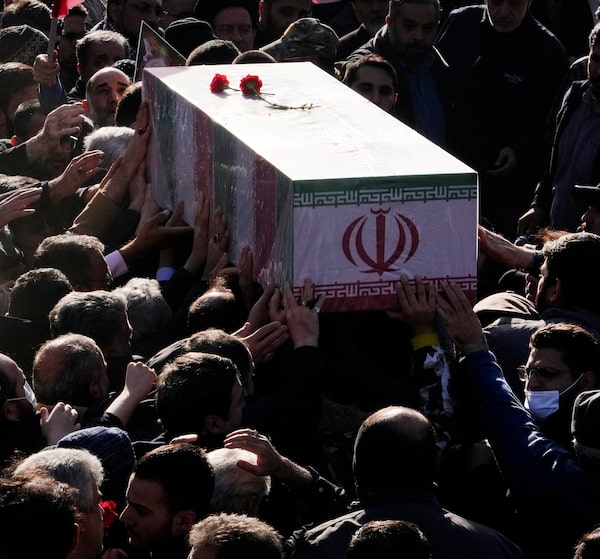
People in Tehran carry the coffin of an Iranian Revolutionary Guard member killed by an Israeli air strike in Syria.Vahid Salemi/The Associated Press
Iran
Tehran seemed caught off guard by the Oct. 7 attack, and initially appeared to accept the likely defeat of its ally Hamas in Gaza. As that conflict has dragged on, Tehran has gradually mobilized more and more of its allies around the region to join the fight.
Iran’s leadership, like the Biden Administration, says it doesn’t want to see a wider war. But Iran and the so-called “Axis of Resistance” – a network of allied militias Tehran has built in Lebanon, Syria, Iraq and Yemen – seem on the verge of a major confrontation with the U.S., Israel or both.
All sides are warning the others not to cross their “red lines,” though it’s increasingly unclear just where those are. As the front-page headline in Wednesday’s Tehran Times put it: “No to war but finger on the trigger.”
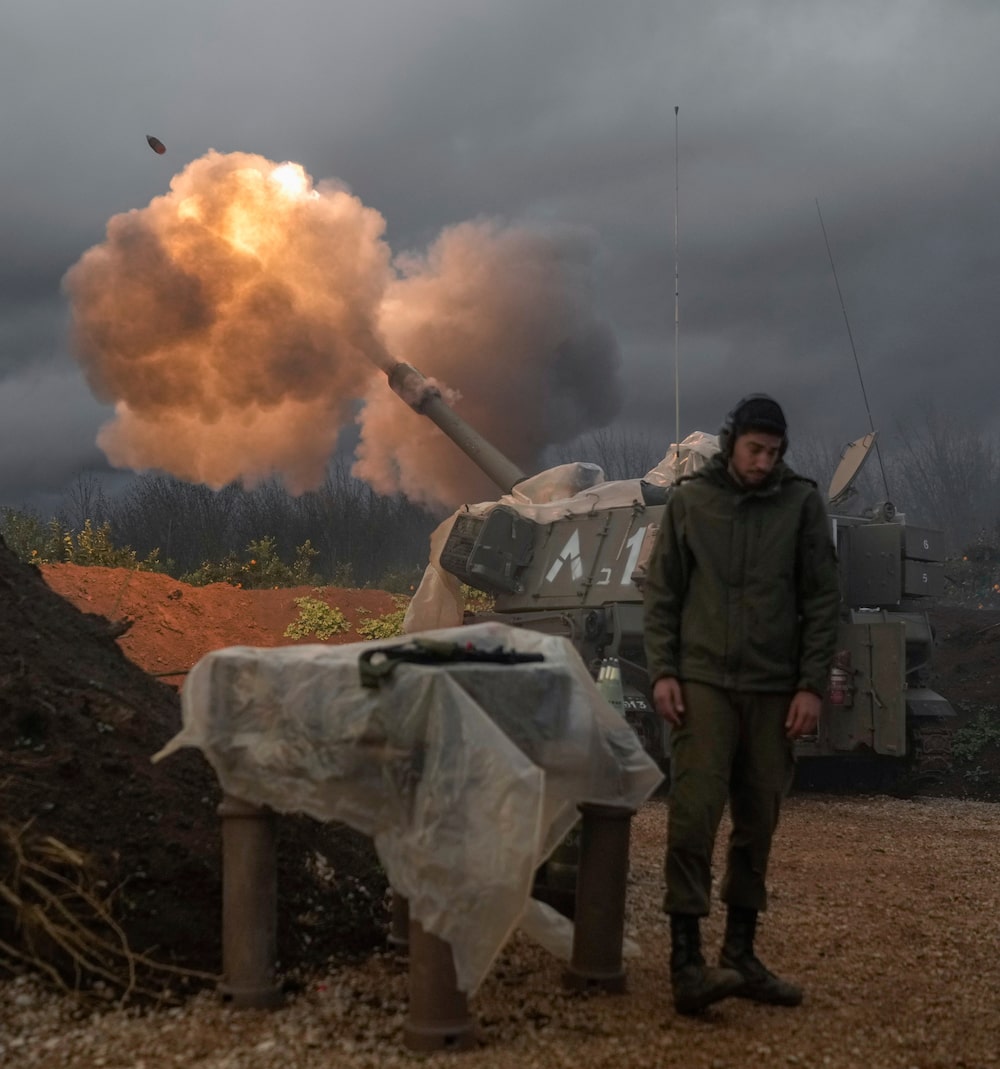
Caught in the middle

RUSSIA
U.S. allies
TURKEY
SYRIA
LEBANON
IRAN
IRAQ
JORDAN
EGYPT
QATAR
SAUDI
ARABIA
OMAN
Houthi-controlled
territory
SUDAN
YEMEN

RUSSIA
U.S. allies
TURKEY
SYRIA
LEBANON
IRAN
IRAQ
JORDAN
EGYPT
QATAR
SAUDI
ARABIA
OMAN
Houthi-controlled
territory
SUDAN
YEMEN

KAZAKHSTAN
U.S. allies
RUSSIA
UZBEKISTAN
GEORGIA
TURKMENISTAN
TURKEY
SYRIA
AFGHANISTAN
LEBANON
IRAQ
IRAN
JORDAN
KUWAIT
BAHRAIN
EGYPT
QATAR
UAE
SAUDI
ARABIA
OMAN
Houthi-controlled
territory
SUDAN
YEMEN
ERITREA
ETHIOPIA
Lebanon
From the moment it launched its operation in Gaza, Israel’s biggest worry has been that Lebanon-based Hezbollah would join the fray and open a second front by raining missiles down on Israel’s north. That has also been the greatest fear of most Lebanese, who remember well the destruction their country suffered during the 33-day Israel-Hezbollah war in 2006.
Israel and the Iranian-backed Hezbollah have been trading near daily artillery strikes across the frontier since October. An average day sees one or more rockets or shells fired from the Lebanese side, followed by an Israeli air strike on the position it was fired from, with both sides calibrating their blows in a way that has kept the situation from escalating into all-out war. So far.
A placard shows the late Hamas deputy leader Saleh al-Arouri at a Jan. 3 funeral in Tyre, Lebanon, for Ahmad Hammoud, who was killed alongside him.Aziz Taher/Reuters
The most dangerous moment since the beginning of the war was the Jan. 2 assassination of a senior Hamas figure, Saleh al-Arouri, in a Hezbollah-controlled neighbourhood of Beirut. Hezbollah leader Hassan Nasrallah has vowed retaliation, though so far there has been no change to the previous pattern of attacks and counterattacks.
Meanwhile, Lebanon’s government is another casualty of the larger regional standoff, with the country’s political factions – who are variously backed by Iran, Syria, Saudi Arabia, the U.S. and France – unable to agree on who should be the country’s president, a post that has been vacant since 2022. The country’s economy has also taken a dramatic plunge since Oct. 7, with the instability scaring off tourists from the entire region.
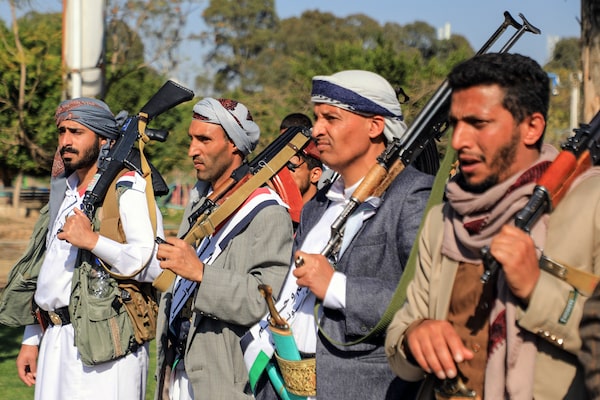
Houthi supporters rally in support of Palestinians in Sana'a on Feb. 1.MOHAMMED HUWAIS/AFP via Getty Images
Yemen
A decade-old civil war between the Iran-backed Houthis and Saudi Arabia-backed government has been secondary since Oct. 7 to the Houthis’ efforts to raise the price of Western support for Israel by targeting commercial shipping in the Red Sea. Now, a country that was already one of the poorest in the world – the United Nations Population Fund says 80 per cent of the country “struggles to put food on the table and access basic services” – is being hit by U.S. and British air strikes.
The Houthis, however, have kept up their attacks, claiming missile strikes on two British-owned container ships in the Red Sea this week, one of which has been confirmed by the company. The Houthis also claimed to have hit and damaged a U.S. warship, though the report was immediately denied by the Pentagon.
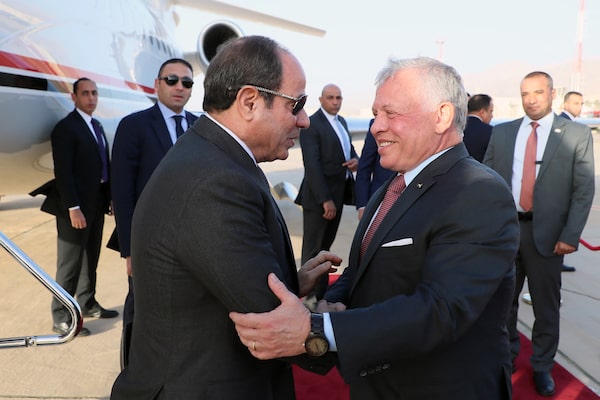
King Abdullah II, right, greets Egypt's President Abdel Fattah el-Sisi in Aqaba, Jordan, on Jan. 10.CHRIS SETIAN/Jordanian Royal Palace/AFP via Getty Images
Jordan
The Hashemite Kingdom has seemingly been caught in the middle of every crisis to hit the Middle East this century. A U.S. ally, and one of the first Arab states to make peace with Israel, it is a state with a powerful internal security service that keeps close watch on the large communities of refugees it hosts from Syria and Iraq, as well as the millions of residents of Jordan who are of Palestinian descent.
Early in the Israel-Hamas war, King Abdullah II warned the conflict had pushed the entire region to the “brink of an abyss.”
Despite the king’s overt frustration with U.S. foreign policy, Jordan has quietly remained a key hub for U.S. military operations around the region – a role that is rarely discussed at home, but which was thrust into the public eye by the Jan. 28 drone strike.
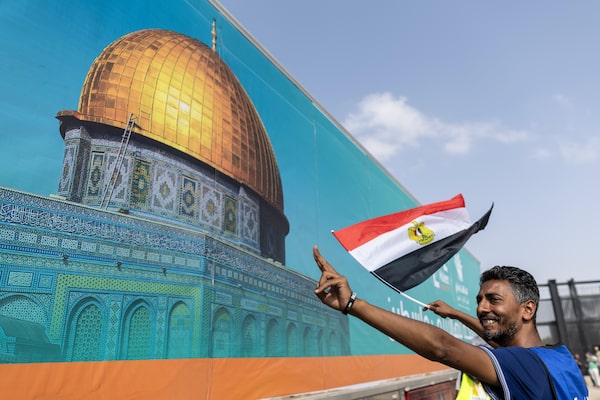
People wave Egyptian flags as aid trucks enter Gaza at Rafah on Oct. 22.Mahmoud Khaled/Getty Images
Egypt
President Abdel Fattah el-Sisi’s regime has been engaged in a delicate dance since Oct. 7, criticizing Israel’s attack on Gaza – and allowing rare public protests so that Egyptians can vent their anger about it – while the Arab world’s largest army does nothing to stop it. Egypt has made a show out of its role helping facilitate the trickle of international aid that has entered the besieged strip, while at the same time keeping its borders tightly sealed so there isn’t a Palestinian exodus into the adjacent Sinai Peninsula.
Egypt says it doesn’t want to play any part in another forced displacement of Palestinians. Mr. el-Sisi’s regime, which toppled an elected Muslim Brotherhood government in a 2013 coup, also doesn’t want Hamas – an armed offshoot of the Brotherhood – setting up shop on its soil.
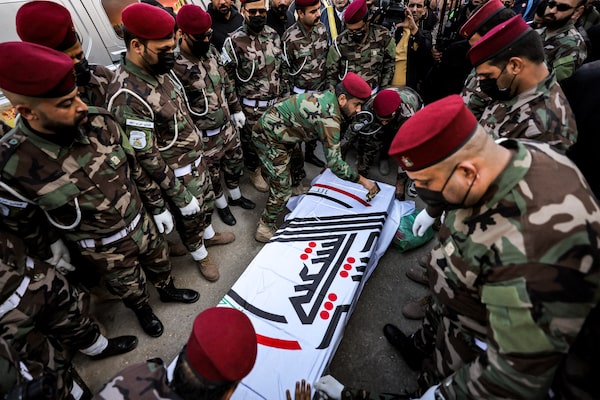
Members of the Iraq-based militant group Kataeb Hezbollah hold a funeral in Baghdad on Dec. 26 for a comrade killed in a U.S. air strike.AHMAD AL-RUBAYE/AFP via Getty Images
Syria and Iraq
Ever since the 2003 U.S. invasion of Iraq, and the 2011 outbreak of civil war in Syria, these two one-time regional powers have been reduced to serving as proxy battlefields where other countries – namely the U.S., Iran, Turkey and Russia – fight their wars.
Since Oct. 7, Iranian-backed militias based largely in Iraq have launched more than 160 attacks on U.S. bases around the region, and on Jan. 15 Iran launched a missile attack on Erbil, the capital of Iraqi Kurdistan and a de facto U.S. protectorate, that killed at least four people.
Meanwhile, Israel has launched a series of strikes on suspected Iranian targets in Syria, while Turkey – waging its own war against Kurdish groups based in northern Iraq and eastern Syria – has launched multiple air strikes against the territory of both countries. On Friday, Syrian state media reported that there had been casualties as a result of the “American aggression” that struck targets near the Iraq-Syria border.
The Jan. 28 attack on the U.S. base in Jordan appears to have been carried out by Kataib Hezbollah, an Iranian-backed militia in Iraq. Three days later, the group – under apparent pressure from both Baghdad and Tehran – said it was “suspending” attacks against U.S. targets “in order to prevent embarrassment to the Iraqi government.” It’s unclear whether it will continue to hold fire after the latest U.S. air strikes.
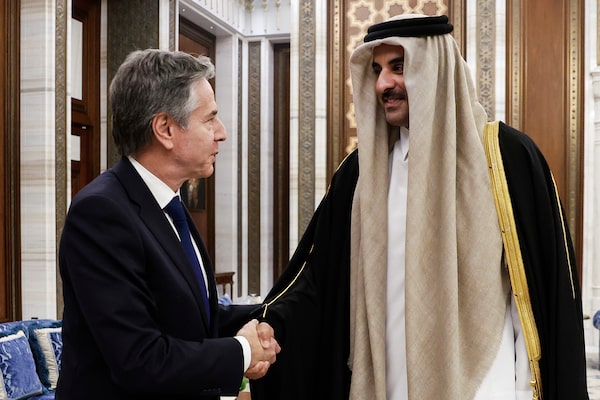
Emir Tamim bin Hamad Al Thani, right, shakes hands with U.S. Secretary of State Anthony Blinken in Lusail, Qatar, on Jan. 7.Evelyn Hockstein/Pool via AP
Qatar
The rulers of this Persian Gulf peninsula have long played a double game, quietly maintaining diplomatic ties with Israel – and hosting the massive Al-Udeid U.S. Air Force base – while at the same time welcoming Hamas leader Ismail Haniyeh and his predecessor Khaled Meshaal in Doha.
That dual role – backed by Qatar’s status as the world’s biggest single donor of aid to pre-war Gaza – has positioned Emir Tamim bin Hamad Al Thani as one of the few people who can hope to mediate peace between the warring parties. Qatar played a key role negotiating a November agreement that saw Hamas release 50 of its Israeli and foreign hostages in exchange for a week-long pause in the Israeli offensive and the release of 150 Palestinian women and children held in Israeli prisons. Qatar is again at the centre of the current ceasefire talks.
The Qataris previously played a similar role in Afghanistan, with Doha hosting the exiled Taliban leadership and facilitating abortive peace talks between the U.S. and the Taliban that collapsed when the Islamic fundamentalists forcibly seized power in Kabul in 2021.
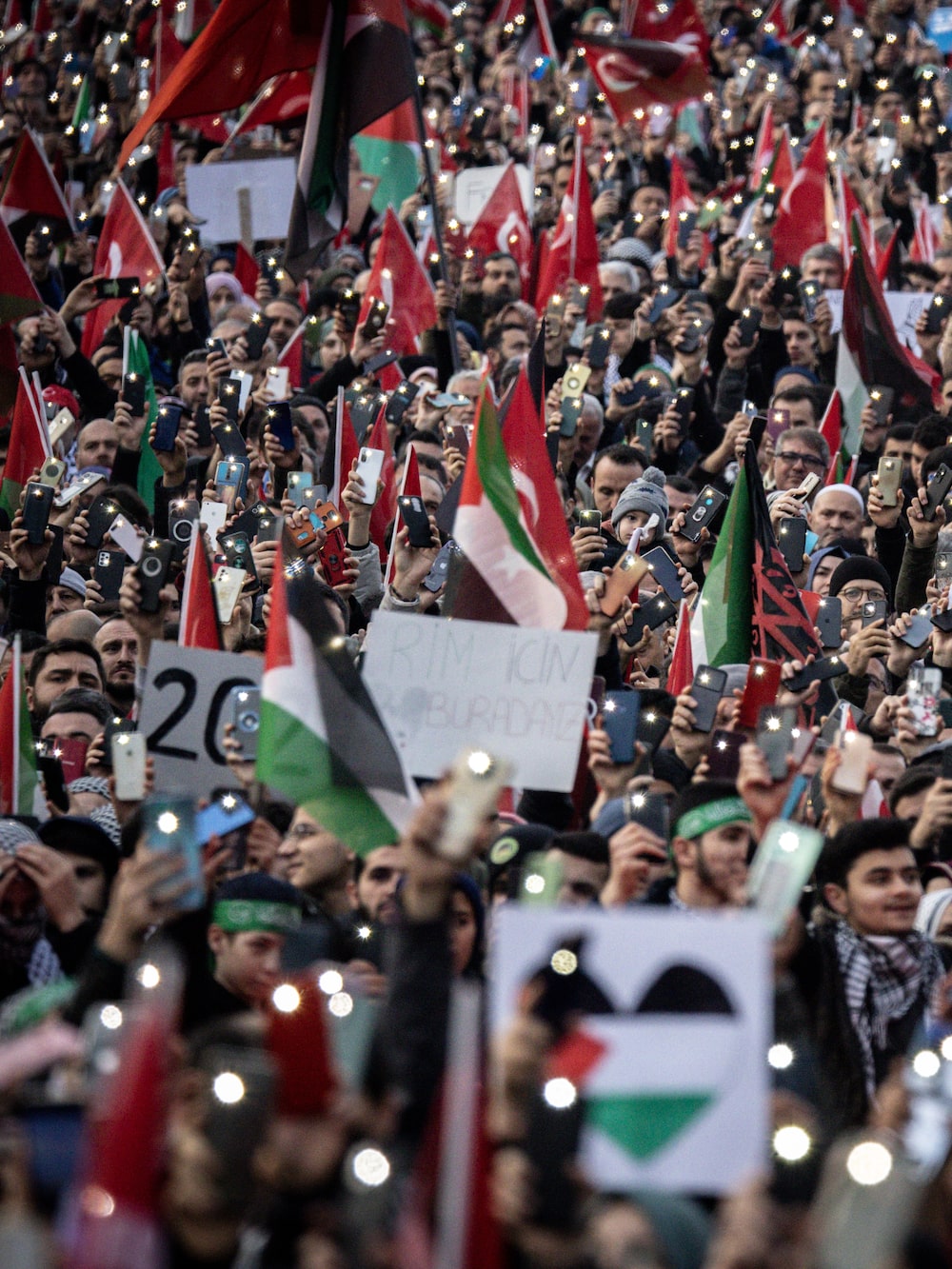
Other players
Saudi Arabia
The Kingdom was moving closer to a breakthrough recognition of Israel when the Hamas attack and the war in Gaza suddenly made such rapprochement impossible. Postwar, that deal – which also included a U.S. commitment to defend Saudi Arabia from Iran – is expected to be back on the table, but only if Riyadh sees a clear path to a Palestinian state.
Russia
Vladimir Putin is one of the few world leaders who has gained from the Gaza war. The attention of everyone from the world’s media to the U.S. military shifted from Ukraine to the Middle East, dealing a blow to morale in Kyiv and adding to the Kremlin’s confidence that it can outlast the West in that war. Russian diplomats have also enjoyed pointing out the hypocrisy in how countries like Canada and the U.S. have shouted for years over the Russian occupation of parts of Ukraine while standing by Israel through its decades-long occupation of Palestinian lands.
Turkish President Erdogan speaks in Berlin during a November visit with Chancellor Olof Scholz.Liesa Johannssen/Reuters
Turkey
Ankara once had warm relations with Israel, but has grown closer to Palestinian groups, including Hamas, under the leadership of President Recep Tayyip Erdogan – and his country has been one of the loudest in denouncing what it has called the “genocide” in Gaza. Turkey has showed its solidarity with Gaza by airlifting dozens of injured Palestinians from Egypt to Turkey for medical treatment.
Tensions between Ankara and Tel Aviv were further escalated by Turkey’s claim last month to have arrested 33 members of Israel’s Mossad intelligence service. Turkey’s official Anadolu wire service reported that the 33 were “alleged to have been involved in activities such as reconnaissance, surveillance, assault, and abduction” – with other media implying the suspects had been hunting down Hamas members living in Turkey.
China
Xi Jinping has continued his recent tactic of lining up on the opposite side of the U.S. in whatever the crisis of the day is.
Beijing has bolstered its standing in the Global South – which broadly supports the Palestinian cause – by calling for a ceasefire and an end to the “collective punishment” of those living in Gaza. As with the war in Ukraine, Beijing has tried to position itself as a player in any future peace process – even as none currently appears on the horizon.
Israel-Hamas war: More from The Globe and Mail
Half a world away from Gaza, a Canadian play about an Israeli first responder is polarizing the B.C. theatre scene. J. Kelly Nestruck, The Globe’s theatre critic, joined The Decibel to explain how the controversy began. Subscribe for more episodes.
From our foreign correspondents
Gaza ‘unbearable,’ says Canadian responsible for UN staff
Israel must take steps to prevent genocide in Gaza, ICJ orders in historic ruling
Commentary
Ayelet Levy Shachar: As the mother of a hostage in Gaza, I feel unbearable anguish and heartbreak
Hussein Ibish: Hezbollah, Israel and the Houthis illustrate a tale of two escalations



 Mark MacKinnon
Mark MacKinnon